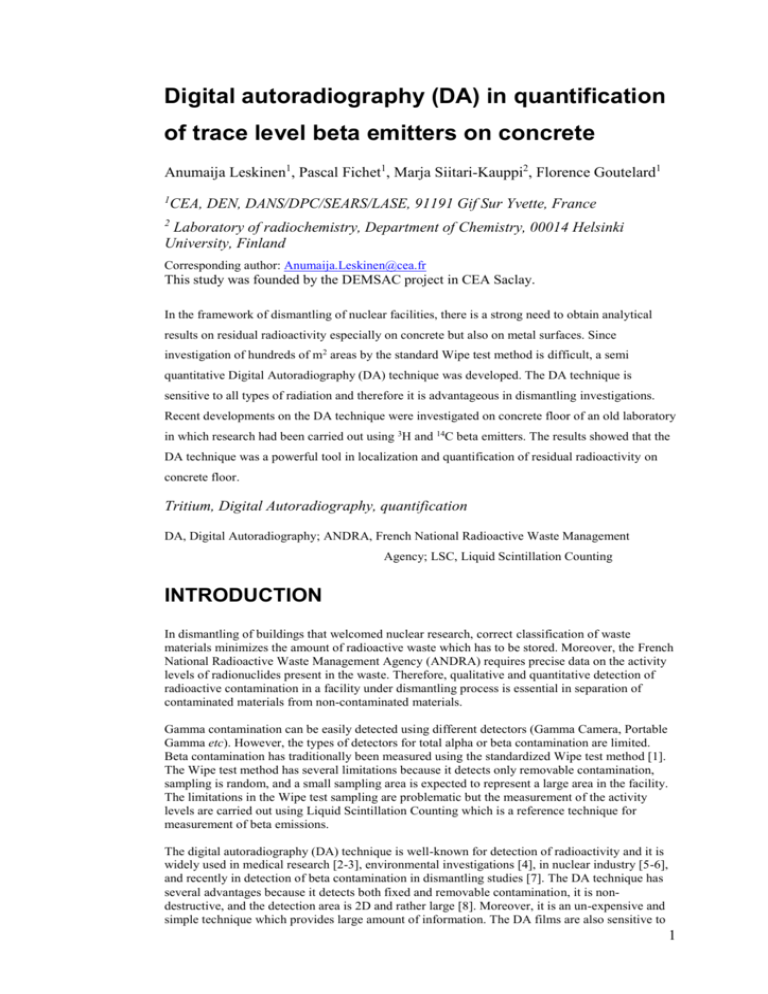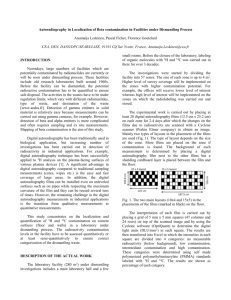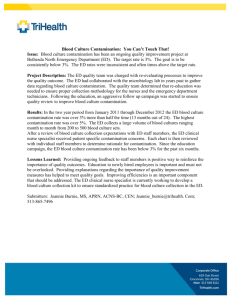Author template for journal articles
advertisement

Digital autoradiography (DA) in quantification of trace level beta emitters on concrete Anumaija Leskinen1, Pascal Fichet1, Marja Siitari-Kauppi2, Florence Goutelard1 1 CEA, DEN, DANS/DPC/SEARS/LASE, 91191 Gif Sur Yvette, France 2 Laboratory of radiochemistry, Department of Chemistry, 00014 Helsinki University, Finland Corresponding author: Anumaija.Leskinen@cea.fr This study was founded by the DEMSAC project in CEA Saclay. In the framework of dismantling of nuclear facilities, there is a strong need to obtain analytical results on residual radioactivity especially on concrete but also on metal surfaces. Since investigation of hundreds of m2 areas by the standard Wipe test method is difficult, a semi quantitative Digital Autoradiography (DA) technique was developed. The DA technique is sensitive to all types of radiation and therefore it is advantageous in dismantling investigations. Recent developments on the DA technique were investigated on concrete floor of an old laboratory in which research had been carried out using 3H and 14C beta emitters. The results showed that the DA technique was a powerful tool in localization and quantification of residual radioactivity on concrete floor. Tritium, Digital Autoradiography, quantification DA, Digital Autoradiography; ANDRA, French National Radioactive Waste Management Agency; LSC, Liquid Scintillation Counting INTRODUCTION In dismantling of buildings that welcomed nuclear research, correct classification of waste materials minimizes the amount of radioactive waste which has to be stored. Moreover, the French National Radioactive Waste Management Agency (ANDRA) requires precise data on the activity levels of radionuclides present in the waste. Therefore, qualitative and quantitative detection of radioactive contamination in a facility under dismantling process is essential in separation of contaminated materials from non-contaminated materials. Gamma contamination can be easily detected using different detectors (Gamma Camera, Portable Gamma etc). However, the types of detectors for total alpha or beta contamination are limited. Beta contamination has traditionally been measured using the standardized Wipe test method [1]. The Wipe test method has several limitations because it detects only removable contamination, sampling is random, and a small sampling area is expected to represent a large area in the facility. The limitations in the Wipe test sampling are problematic but the measurement of the activity levels are carried out using Liquid Scintillation Counting which is a reference technique for measurement of beta emissions. The digital autoradiography (DA) technique is well-known for detection of radioactivity and it is widely used in medical research [2-3], environmental investigations [4], in nuclear industry [5-6], and recently in detection of beta contamination in dismantling studies [7]. The DA technique has several advantages because it detects both fixed and removable contamination, it is nondestructive, and the detection area is 2D and rather large [8]. Moreover, it is an un-expensive and simple technique which provides large amount of information. The DA films are also sensitive to 1 both high and low energy radiations [9], they are re-usable [8], they have high spatial resolution [8], and they have a wide dynamic range [8]. This study concentrated on the localization and quantification of 3H and 14C contamination on concrete floor in an old laboratory using the DA technique. Samples were taken from the floor after localization of contamination in order to verify the activity levels and nuclides present using LSC. The sampling results were compared with the results provided by the DA technique. EXPERIMENTAL SET-UP The DA Technique The DA Technique has been widely used in biological research to observe radiolabeled molecules. This analytical technique uses films, also called screens, which are sensitive to all types of radiation. Perkin Elmer has developed so called TR films which are particularly sensitive to 3H and 14C. These films contain photostimulable crystals which can accumulate and store radiation information when placed in close contact with a radiation source. The exposure time varies depending on the radionuclide and its activity and therefore it must be optimized experimentally. The accumulated signal can be scanned by a laser installed in a Cyclone Plus Device (Perkin Elmer). The scanner converts the accumulated signal into digital form which is presented as a 2 dimensional image. The radiation information can be shown as shades of gray varying from white to black as shown in Figure 1. The increase in the intensity of the gray color corresponds to increasing radioactivity of the source. The unit of these intensity values is Digital Light Unit (DLU, a numerical value connected to the color scale). The scanner is operated with a software (called OptiQuant) which was originally developed to investigate small areas on one film. In the dismantling study, up to 30 TR films were used and a methodology to compare the intensity values of the films was developed. DA films have also a very important quality in dismantling process, i.e. films are reusable. After accumulation of the exposure data and scanning, films are exposed to high intensity light that erases the exposure information from the film. The erased films can be reused up to several hundreds of times. The investigated laboratory The old laboratory under dismantling process included a main laboratory hall, two offices, an entrance room and small rooms for fridges etc. The combined floor area is 285 m2. Labeling of amino acids with 3H and 14C were carried out in the laboratory over 3 decades until its closure in 1995. The equipment and furniture were removed from the laboratory prior to the contamination studies using the DA technique. The floor of the laboratory was divided to 57 Zones using spray paint (Figure 2). Each zone was approximately 4 m2. Higher level of survey coverage was implemented on the zones with higher contamination potential. For example, the offices received lower level of investigations whereas high number of studies was carried out on the zones on which radiolabeling had been carried out. Radioactive survey of the laboratory using the DA Technique The experimental work was started by drawing a grid on a zone. The size of the grid depended on the size of the Zone and the potential contamination (Figure 3). Typically, 20 identical TR films (12.5 cm x 25.2 cm, PerkinElmer) were placed on a zone as seen in black in Figure 3. The TR films were placed directly on concrete in close contact. Investigation of 100% of each zone area is time consuming and unpractical especially on uncontaminated zones. However, placement of 20 TR films covers already a large area as seen in Figure 3 (on the right, 126 cm * 187.5 cm = 2.36 m2). Therefore, more TR films were placed on the zone only when contamination was detected. A background TR film was placed next to the other TR films but a shielding layer (thick cardboard) was placed between the floor and the background film. All the films were covered with cardboard and a sheet in order to protect the films from moisture, sunlight and displacement during 2 the exposure. The films were collected from the zone after 2-4 days exposure time and scanned with 300 dpi (dot per inch) resolution using Cyclone Plus Device (Perkin Elmer). High resolution is not as important in dismantling studies as it is in biological or medical research because resolution of a centimeter or even higher may be sufficient in order to detect trace level radioactivity on concrete. Quantitation of the radioactivity results After the films were scanned, the interpretation process of the images was started using the OptiQuant software. An interpretation grid of 5 x 5 mm squares (47 columns and 24 rows = 1128 squares) was placed on the background image and the DLU/mm2 values in each square were determined. This resolution was chosen arbitrarily to be more applicable in dismantling studies compared to the original resolution of biological needs (typically some decades of µm) provided by the OptiQuant software. The results were then copied into Excel in which a homemade Macro calculated the average DLU/mm2 value of the background image with standard deviation. The average DLU/mm2 value and the standard deviation (σ) were used to calculate the corrected background value (Equation 1). The corrected background (B(0)) value was determined separately for each set of films because background level depended on the time duration and possible presence of radiation interferences. B(0) = 𝐵(𝑎𝑣𝑒𝑟𝑎𝑔𝑒) + 10σ (1) B(average) = average DLU/mm2 value of the background film σ = standard deviation of the DLU/mm2 values of the background film The interpretation process was continued by placing the same interpretation grid on each image and the DLU/mm2 values were transferred into the Excel Macro for each investigated film. The Excel Macro divided the DLU/mm2 values into Radioactivity Levels (Table 1). The determination of the limits of the Radioactivity Levels was carried out using certified 3H and 14C digital autoradiography standards manufactured by American Radiolabeled Chemicals. These standards enabled establishment of correlation between the intensity values on the films (DLU/mm 2) and activity values in Bq/cm2 or Bq/g. The selection of the limits of the Radioactivity Levels depended on the objective to detect low level 3H and 14C activities in order to isolate contaminated concrete from non-contaminated concrete. Comparison of intensity values by similar activities of 3H and 14 C showed that the intensity values on the TR films are significantly higher for 14C compared to 3 H. For example, the intensity value on the TR film by 1.2 kBq/cm2 of 14C (6944953 DLU/mm2) was approximately 300 times higher than the intensity value of 1.1 kBq/cm2 of 3H (23450 DLU/mm2). Therefore, the first 4 Radioactivity Levels of 14C were estimations of trace levels whereas the 3H Radioactivity Levels varied from background to above 210 Bq/cm2. After all the images were interpreted as described above, the results of all the TR films of each zone were combined in a pie graph as percentage of the first 4 Radioactivity Levels. Since separate detection of 3H and 14C was not carried out, the pie graphs show that in each Radioactivity Level, the intensity values may originate from 3H or 14C contamination or a mixture of both radionuclides. We assume also that no other emitters can interfere. It is also noteworthy to mention that the standards were deposited on plastic whereas the investigations were carried out on concrete. Therefore, possible matrix effect may cause difference in the intensity values of same activities measured on plastic and on concrete. Sampling The scanned images (Figure 1 as an example) were used to localize the radioactivity on the floor and sampling was carried out using a hammer and a chisel. Detection of the radionuclides in the samples was carried out using pyrolysis followed by LSC. Known amount of sample was slowly introduced into a pyrolyzer (maximum temperature at 900 ⁰C) and constant flow of oxygen collected the released 3H and 14C into 0.2 M HCl and Carbosorp, respectively. 10 ml of liquid scintillation cocktail (UltimaGold LLT, Perkin Elmer) was mixed into the samples after which their activities (Bq/g) were measured in LSC. The sampling results were then compared with the results provided by the Radioactivity Levels in order to verify the accuracy of the DA technique. 3 Comparison was carried out using 14C activities because its significantly higher response on the TR films compared to 3H. The sampled areas were interpreted the same way as described above but the Radioactivity Levels were expressed as Bq/g since the sampling results are expressed as Bq/g. The number of squares in the interpretation grid depended on the size of the sampled area. Figure 4 shows an example image in which 9 squares (5 mm x 5 mm) covered the sampled area. The sampling and the DA results were considered to be comparable in cases when the DLU/mm 2 values in the squares of the sampled areas were mainly in the corresponding Radioactivity Level. Results and Discussion In total, 1569 films were placed on the concrete floor in the contamination investigations of the old laboratory under dismantling process. The coverage area was almost 50 m2 which corresponded to approximately 18% of the 285 m2 floor area. Even though 100% coverage was not obtained, the DA technique provided large amount of information (1569 films x 1128 data points/film = 1769832 data points) on the contamination in reasonable time i.e. 10 months. The time duration is mainly due to time collection of the films. Due to the large amount of information, the presentation of the results was carried out by dividing the facility into 5 regions as seen in Figures 5 to 9. The results show that the contamination was localized in the center and back of the laboratory. 3H and 14 C activities were measured in 43 samples collected from the floor and the results showed that the contamination was mainly 14C. Once a zone was investigated with the Digital Autoradiography technique, the trace level radioactivity was visualized by reassembling of the scanned images. Since the printouts of the scanned images obtained with OptiQuant (Figure 10) are in 1 to 1 scale, reassembling of the printouts provided a real size visualization of the contamination. Comparison of the scanned images with the floor surface showed contamination patterns. For example, in Zone 18, the contamination pattern in the scanned images (Figure 10, A) suggested contamination under a yellow layer (Figure 10, B). Samples were taken from the yellow layer and concrete underneath it and contamination was measured in both samples. Therefore, visualization of the contamination and comparison of the images with the floor structure indicated presence of radioactivity which was not initially detected (radioactivity under the initial layer). The sampled areas were interpreted with the Radioactivity Levels and 67% of the 43 results were comparable with each other. The results are summarized in Figure 11. The Radioactivity Levels were plotted on the x-axis whereas the sampling results (14C) were plotted in y-axis. The results show that the 14C activities of the samples studied were mainly between 700 and 25 000 Bq/g. A significant number of non-comparable results were observed in the highest Radioactivity Level (> 77 kBq/g) in which 5 out of 7 results were non-comparable. In these cases the sampled 14C activities were approximately 10 kBq/g whereas their intensity values suggested activities more than 77 kBq/g. This can be caused by a very thin 14C contamination layer which was diluted by the bulk in sampling. In theory, the DA technique and sampling are comparable only in cases when the bulk is homogenously contaminated since DA technique detects only surface activities. The applicability of DA technique in dismantling studies was evident since even low level radioactivity was detected. When the results were shown as pie graphs in each zone, the result map clearly showed the contaminated and non-contaminated areas. Comparison of the contamination patterns with the structure of the floor indicated areas in which contamination was found under the initial surface layer. These results can be easily interpreted in order to make a decision on separation of non-contaminated areas which can be dismantled without any special treatment from contaminated areas. Conclusions This paper showed that the Digital Autoradiography (DA) technique can be used in detection of beta-contamination on concrete. The DA images were interpreted using the Radioactivity Levels in which the low contamination was presented as increasing surface activities. Comparison of the results provided by the Radioactivity Levels with the sampling results showed that the methods are 4 comparable. Therefore, the DA technique is an efficient, non-destructive technique in detection of beta-contamination on concrete compared to the Wipe test method. The advantages in using digital autoradiography in dismantling investigations are evident: the technique is easy to use, it does not require expensive equipment, it is non-destructive, and contamination can be both localized and quantified. In addition, the placement/collection of 20-30 films can be carried out within 30 minutes and therefore the worker is exposed to radiation only short periods of time. This is a significant advantage especially when gamma-radiation is present in the facility. The DA technique in dismantling studies is still in working progress and many improvements are under development. The optimum way to present the results is in deep discussion. Also the spatial resolution chosen in these studies (5 x 5 mm) may be unnecessary high considering that facilities under dismantling process may cover hundreds or thousands of square meters. ACKNOWLEDGEMENTS Authors would like to thank particularly Nadine Evenat-Robic for her help and her proposition to test the DA technique in situ in a laboratory under dismantling process. REFERENCES [1] ISO standards (1988) Evaluation of surface contamination - Part 2: Tritium surface contamination. 7503-2:1988 [2] Hirota M, Takada C, Takasaki K, Momose T, Kurihara O, Saze T, Ito S, Nishizawa K (2011) Feasibility of in vivo measurement of 239Pu distribution in lungs using an imaging plate. Appl Radiat Isotop 69:808-813 [3] Yamane Y, Ishide N, Kagaya Y, Takeyama D, Shiba N, Chida M, Sekiguchi Y, Nozaki T, Ido T, Shirato K (1995) Quantitative double-tracer autoradiography with tritium and Carbon-14 using imaging plates: Application to myocardial metabolic studies in rats. J Nucl Med 36:518-524 [4] Koarashi J, Saito F, Akiyama K, Rahman NM, Iida T (2007) A new digital autoradiographical method for identification of Pu particles using an imaging plate. Appl Radiat Isot 65:413-418 [5] Sugiyama K, Tanabe T, Miyasaka K, Masaki K, Tobita K, Miya N, Philipps V, Rubel M, Skinner CH, Gentile CA, Saze T, Nishizawa K (2004)Tritium profile in plasma-facing components following D-D operation. J Nucl Mater 329-333:874-879 [6] Kobayashi K, Isobe K, Iwai Y, Hayashi T, Shu W, Nakamura H, Kawamura Y, Yamada M, Suzuki T, Miura H, Uzawa M, Nishikawa M, Yamanishi T (2007) Studies on the behavior of tritium in components and structure materials of tritium confinement and detritiation systems of ITER. Nucl Fusion 47:1645-1651 [7] Fichet P, Bresson F, Leskinen A, Goutelard F, Ikonen J, Siitari-Kauppi M (2012) Tritium analysis in building dismantling process using digital autoradiography. J Nucl Chem 291:869-875 [8] Takebe M, Abe K, Kondo Y, Satoh Y, Souda M (1995) Identification of ionizing radiation with an imaging plate using two-wavelength stimulation light. Jpn J Appl Phys 34:41974199 5 [9] Motoji N, Kuroiwa H, Shigematsu A (1995) Studies on the quantitative autoradiography IV Quantitative reliability of TLC-autoradioluminography. Biol Pharm Bull 18:108-114 Figure 1. Example image showing a DA result: intensity values presented in gray scale to have a visible illustration of radioactivity Figure 2. Zones in the laboratory: entrance room (1), offices (2-3), small rooms (43-51), main laboratory (4-42, 52-57) 6 Figure 3. The two main grids (10 x 4 and 15 x 5) in the placements of the films (marked in black) on the floor Figure 4. Interpretation grid on a sampled area 7 Figure 5. Results in the region 1 of 5 in the laboratory. Zone 27 was not accessible Figure 6. Results in the region 2 of 5 in the laboratory 8 Figure 7. Results in the region 3 of 5 in the laboratory Figure 8. Results in the region 4 of 5 in the laboratory 9 Figure 9. Results in the region 5 of 5 in the laboratory 10 a) b) Figure 10. Reassembled scanned images (a) and picture (b) of Zone 18 11 Figure 11. Comparison of Sampling results with Radioactivity Levels. The y-axis is in log-scale Table 1. Intensity and surface activity values of the Radioactivity Levels (DLU/mm2) 3 14 1 0 - Corrected Background Background Background 2 Corrected Background - <100 <<1 Radioactivity H (Bq/cm2) C (Bq/cm2) Level 3000 3 3000-5500 100-210 <1 4 5500-210000 210-8100 1-25 5 210000-630000 8100-24400 25-75 6 >630000 >24400 >75 12







